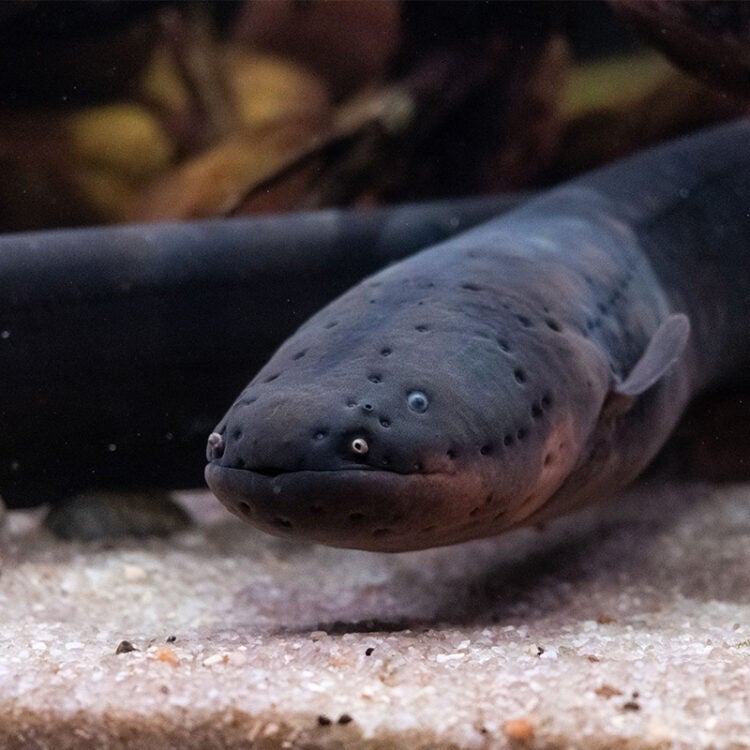-
Size
Up to 8 feet (2.5 m) -
Diet
Diet consists of smaller fish and amphibians -
Range
Amazon basin, the Orinoco River and the Guyanas -
Habitat
Murky water in pools, deeply shaded streams and creeks
Physical Characteristics
- The electric eel is the largest of the knifefish and can grow to be almost 8 feet (2.5 m) and weigh up to 44 lbs. (20 kg).
- It is a long-bodied fish with a flattened, broad head. The body is cylindrical toward the front, becoming compressed laterally toward the tail.
- The elongated, scaleless body is olive to black in color with a yellow or orange-hued throat region.
- It has an elongated anal fin that runs most of the length of its body and small pectoral fins. All other fins are absent.
- The electric eel has a large mouth with one row of cone-shaped teeth on each jaw.
- Its electric organs consist of flattened columns of electroplates arranged in rows along its sides behind the head. Electroplates are composed of a series of hundreds of thousands of electrocyte cells. The power of its electric discharge increases with its body length.
Animal Fun Fact
In addition to protection and stunning prey, the electric discharge of the electric eel is also used for navigation and social communication.
Diet / Feeding
- Adults feed on smaller fish and amphibians. They can immobilize or kill their prey with an electric discharge.
- Juveniles will consume mainly bottom-living invertebrates.
Range / Habitat
- Occurs in the Amazon basin, the Orinoco River and the Guyanas.
- Lives in murky water in pools, deeply shaded streams and creeks
- This species prefers muddy bottoms in calm waters and is often found on coastal plains, swamps, and creeks.
- Common throughout its range.
Reproduction & Growth
- Oviparous- egg-laying species.
Conservation Status
- “Least Concern” on the IUCN Red List.
Additional Information
- The electric eel is not aggressive. The primary uses of its electric charge are for defense against potential predators and to subdue prey. It can produce a shock exceeding 500 volts.
- The vital internal organs of this eel are compressed into the anterior (front) 1/8 of its body near its head. The rest of its body is the electricity-producing tail.
- This species is an obligate air-breathing fish that absorbs 80 percent of its required oxygen by taking air in through the mouth. Vascular folds in the lining of the mouth absorb the oxygen. This air is later released through the gill slits in the form of bubbles.
- The electric eel will drown if denied access to atmospheric air. However, as long as its skin is kept moist, it can survive for several hours out of the water.
- This species is nocturnal. It hides during the day under shelter or in holes.
- In addition to protection and stunning prey, the electric discharge is also used for navigation and social communication. The electric eel is able to create an electric field surrounding itself that compensates for its poor eyesight in its murky water habitat. This method is similar in nature to echolocation, which is used by bats and dolphins in their respective environments for similar purposes. By using its electric receptors, an eel can identify non-electrical fish, as well as detect the heartbeat of other animals nearby. In addition, it may also be able to identify other electric eels in surrounding waters.
Sources
- www.fishbase.org
- http://www.aip.org/radio/scripts/electric eels.txt
- www.whozoo.org
- Fishes of the World, An Illustrated Dictionary. Wheeler, A., pgs. 181-182
- Encyclopedia of Fishes, 2nd Edition. pg. 112







